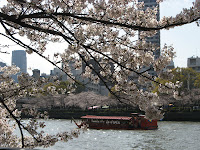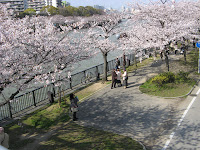Our Easter long weekend began with a short flight to Bangkok, where we were in transit for an hour before boarding a flight bound for Osaka. We were very excited to go back to Osaka, especially after a very memorable and wonderful visit in June 2008. Osaka is situated in the central region of Japan and is Japan's third largest city. The main purpose of our visit was to see the cherry blossoms (Sakura). Cherry blossoms flower at different times throughout Japan and their appearance is determined by geographical location and climate. On Japan's southern, subtropical islands like Okinawa, where the climate is milder, the blossoms can be seen as early as January. However on the northern islands like Hokkaido, the flowers are known to bloom as late as May. In the central region, cherry blossom season is usually around the end of March and beginning of April.
The cherry blossom season is short. Full bloom (Mankai) is usually reached within one week of the opening of the first blossoms (Kaika). The blossoms start falling from the trees about a week after full bloom. That said, strong winds and rain can cut the blooming season even shorter. Although we had planned and booked our trip in January, we were following the cherry blossom calender closely the weeks and days leading up to our trip. The cherry blossom season started early this year and we were on schedule to arrive in Osaka and Kyoto at full bloom (yay!). However, a few days before we were scheduled to arrive in Osaka and Kyoto, the weather turned cold and so when we did arrive, we were a little too early for full bloom in some places. Despite not all the trees being in full bloom, we got to see our fair share of beautiful cherry blossoms. We also got to see how the Japanese people savour and enjoy this season. Cherry blossom viewing (Hanami) is an important social event for Japanese people. During Hanami, people have picnics, gatherings and parties with family, friends and co-workers under the cherry trees.
In Osaka, the weather was cold but sunny, so many of the parks and public places were crowded with locals and visitors sitting under the cherry trees. It was such a festive and happy atmosphere everywhere, with people eating, laughing and enjoying themselves, while admiring the beautiful blossoms.
The cherry blossom season is short. Full bloom (Mankai) is usually reached within one week of the opening of the first blossoms (Kaika). The blossoms start falling from the trees about a week after full bloom. That said, strong winds and rain can cut the blooming season even shorter. Although we had planned and booked our trip in January, we were following the cherry blossom calender closely the weeks and days leading up to our trip. The cherry blossom season started early this year and we were on schedule to arrive in Osaka and Kyoto at full bloom (yay!). However, a few days before we were scheduled to arrive in Osaka and Kyoto, the weather turned cold and so when we did arrive, we were a little too early for full bloom in some places. Despite not all the trees being in full bloom, we got to see our fair share of beautiful cherry blossoms. We also got to see how the Japanese people savour and enjoy this season. Cherry blossom viewing (Hanami) is an important social event for Japanese people. During Hanami, people have picnics, gatherings and parties with family, friends and co-workers under the cherry trees.
In Osaka, the weather was cold but sunny, so many of the parks and public places were crowded with locals and visitors sitting under the cherry trees. It was such a festive and happy atmosphere everywhere, with people eating, laughing and enjoying themselves, while admiring the beautiful blossoms.
Banpaku-koen
Also known as the Expo '70 Commemorative Park, this was the original site of the 1970 World Exhibition in Osaka. After the 1970 World Exhibition it was turned into a public park, where today there are over 5000 cherry trees scattered throughout the park. This park is also home to the National Museum of Ethnology, the International Institute of Children's Literature in Osaka and the Japan Folk Crafts Museum. We took the subway and then the Osaka Monorail (the longest Monorail in the world) to get to this park. We arrived relatively early and already there were many people streaming in to the park to secure their spots under the trees. At the entrance to the park, we came face-to-face with the Tower of the Sun (Taiyo-no-to), which was the symbol of the Expo. This tower has three faces representing the past, present and future, and it is a very unique looking tower. We then spent a few hours walking around the beautiful grounds, where we visited the Natural and Cultural Gardens (Shizenbunkaen) and the Japanese Garden.















Tea at Tea House Senri-an
After walking around the Expo '70 Commemorative Park for a few hours, we decided to stop for a tea break at this beautiful tea house situated in the Japanese garden. The setting of this tea house was perfect - surrounded by cherry trees and a very Zen garden. This tea house served only one type of tea - Matcha green tea (Sam's favourite), which we enjoyed with wagashi (traditional Japanese confectionery). The wagashi in this case was a steamed bun with sweet Adzuki bean paste inside - a delicious compliment to the Matcha tea. Match tea is made from finely milled green tea and it is the tea that is served during the Japanese tea ceremony. To make Matcha tea, the Matcha green tea powder is placed in a bowl with hot water (not boiling), and it is then whisked with a bamboo whisk (chasen) until it becomes frothy and the powder is completely dissolved.
After walking around the Expo '70 Commemorative Park for a few hours, we decided to stop for a tea break at this beautiful tea house situated in the Japanese garden. The setting of this tea house was perfect - surrounded by cherry trees and a very Zen garden. This tea house served only one type of tea - Matcha green tea (Sam's favourite), which we enjoyed with wagashi (traditional Japanese confectionery). The wagashi in this case was a steamed bun with sweet Adzuki bean paste inside - a delicious compliment to the Matcha tea. Match tea is made from finely milled green tea and it is the tea that is served during the Japanese tea ceremony. To make Matcha tea, the Matcha green tea powder is placed in a bowl with hot water (not boiling), and it is then whisked with a bamboo whisk (chasen) until it becomes frothy and the powder is completely dissolved.





Kema Sakuranomiya Koen
Kema Sakuranomiya Koen is a park that is situated along the Okawa River. The park stretches over 4 kilometres and there are about 4800 cherry tress along the river on both sides. The cherry trees in this park were in full bloom and they were spectacular. We walked a good part of the 4 kilometres on the promenade along the river and did some people watching. There were parts of the park that were just packed with people. The most unusual site for us, was a group of about twenty Japanese businessmen, all dressed in suits sitting under the cherry trees enjoying their bento box lunches.
Kema Sakuranomiya Koen is a park that is situated along the Okawa River. The park stretches over 4 kilometres and there are about 4800 cherry tress along the river on both sides. The cherry trees in this park were in full bloom and they were spectacular. We walked a good part of the 4 kilometres on the promenade along the river and did some people watching. There were parts of the park that were just packed with people. The most unusual site for us, was a group of about twenty Japanese businessmen, all dressed in suits sitting under the cherry trees enjoying their bento box lunches.


















Osaka-jo
Osaka-jo is the castle that was built in 1580 by Toyotomi Hideyoshi after he unified Japan. Toyotomi Hideyoshi is considered by Japanese people to be one of the most significant and important figures in Japanese history. This castle and surrounding park is popular with locals and tourists, especially during cherry blossom season and the autumn-foliage season. We visited the inside of this castle and the 8th floor observation deck during our visit in 2008, so we decided to just walk around the grounds of the castle and enjoy the cherry trees which were in full bloom here.
Osaka-jo is the castle that was built in 1580 by Toyotomi Hideyoshi after he unified Japan. Toyotomi Hideyoshi is considered by Japanese people to be one of the most significant and important figures in Japanese history. This castle and surrounding park is popular with locals and tourists, especially during cherry blossom season and the autumn-foliage season. We visited the inside of this castle and the 8th floor observation deck during our visit in 2008, so we decided to just walk around the grounds of the castle and enjoy the cherry trees which were in full bloom here.














Depachika at Takashimaya
No visit to Japan is complete without a visit to a Depachika ! Depachikas are food halls that are located in the basements of department stores. One of the biggest department stores in Japan is Takashimaya (we even have one in Singapore!). It is one of the best department stores in Asia and we were fortunate in that the Osaka Takashimaya store, is located in the same complex as the Swissotel Nankai Osaka where we stayed. We just love visiting these depachikas (we can spend hours there), as they are a window to the Japanese food culture. The variety of foods for sale (lots of gourmet food) is just mind boggling and everything is beautifully packaged (and we mean everything!). Most of the food sold here is of the highest quality and comes with high price tags to match. We were shocked to see a box of the biggest and most perfectly formed cherries sell for a whopping 12,600 Yen (about $ 135.00 Canadian dollars) !
No visit to Japan is complete without a visit to a Depachika ! Depachikas are food halls that are located in the basements of department stores. One of the biggest department stores in Japan is Takashimaya (we even have one in Singapore!). It is one of the best department stores in Asia and we were fortunate in that the Osaka Takashimaya store, is located in the same complex as the Swissotel Nankai Osaka where we stayed. We just love visiting these depachikas (we can spend hours there), as they are a window to the Japanese food culture. The variety of foods for sale (lots of gourmet food) is just mind boggling and everything is beautifully packaged (and we mean everything!). Most of the food sold here is of the highest quality and comes with high price tags to match. We were shocked to see a box of the biggest and most perfectly formed cherries sell for a whopping 12,600 Yen (about $ 135.00 Canadian dollars) !



















This comment has been removed by a blog administrator.
ReplyDelete